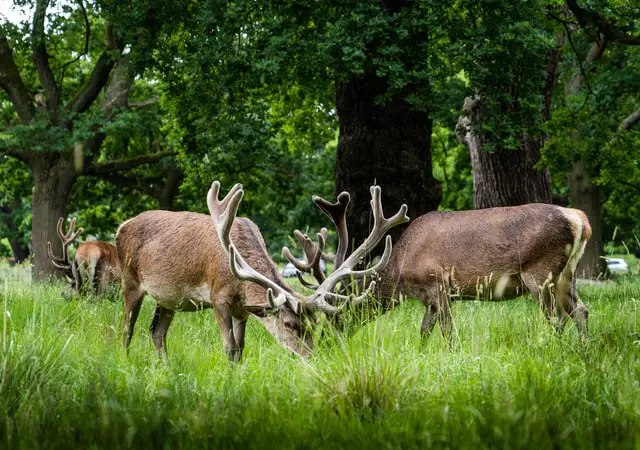England, a land steeped in history and culture, is often celebrated for its ancient castles, picturesque villages, and rolling green hills. Yet, beneath this postcard-perfect landscape lies a lesser-known, but equally enchanting world – its diverse and thriving animals and wildlife. In this journey, we’re going to lace up our hiking boots, grab our binoculars, and set off on an unforgettable adventure to discover the animals and wildlife of England.
This blog is going to pinpoint a few animals which are worthwhile looking out for when you’re next in the United Kingdom.
Key points
| Key Points | Details |
|---|---|
| Red Deer | – Native species migrated to Britain 11,000 years ago |
| – Population decline due to agriculture, forest loss | |
| – Victorian reintroductions, escapes from parks, natural spread | |
| – Found in Scottish Highlands, SW England, other scattered populations | |
| Gray Seals | – Larger of two UK seal species, Halichoerus grypus |
| – Feed at sea, come to land to rest, give birth to pups | |
| – Distinguished from common seals by size, head shape | |
| Hedgehogs | – Small mammals with quills, solitary, nocturnal |
| – Habitat: Europe, Asia, Africa, New Zealand | |
| – Homes: burrows, nests made from leaves, branches | |
| – Sleep up to 18 hours a day, poor eyesight, rely on hearing and smell | |
| Basking Sharks | – Second largest shark after Whale Shark |
| – Filter feeders, follow plankton blooms | |
| – Large, but not aggressive or dangerous | |
| – Ovoviviparous reproduction, live birth | |
| – Ovovivipary: eggs retained internally, young grow inside |
Red Deer
Red deer have been a part of Britain’s natural heritage for over 11,000 years, having made their way from Europe during the migration era. In the Mesolithic period, these majestic creatures were crucial for human survival, providing food, skins, and materials for tools, including bones and antlers. However, with the advent of the Neolithic era and the rise of agriculture, extensive clearing of forests to create farmland significantly impacted their habitats. This deforestation led to a notable decrease in red deer numbers, eventually restricting them primarily to the Scottish Highlands, south-west England, and a handful of other isolated areas.
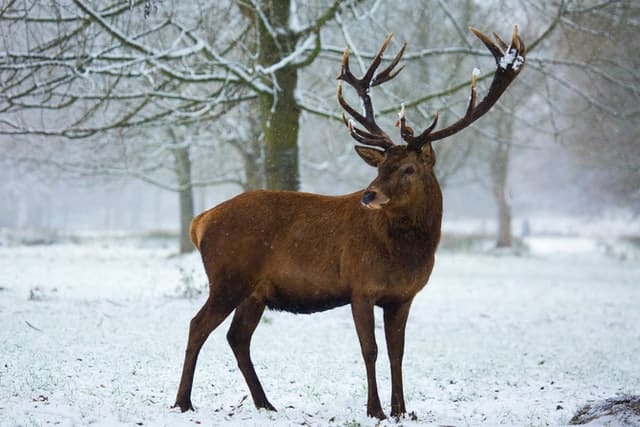
During the Norman era, deer, particularly the red deer, were safeguarded in designated parks and ‘forests’ – which, contrary to the name, often lacked trees – for the exclusive purpose of royal hunting. However, this protection waned in the Medieval period, leading to a significant reduction in their populations across England. In the Victorian era, efforts to revive their numbers involved introducing ‘enhanced’ breeds, which were frequently crossbred with larger species like wapiti, resulting in escapes from deer parks. Coupled with natural expansion, an increase in red deer in the Highlands, and the growth of forest and woodland areas since the early 20th century, red deer have now not only regained their presence across England but are also increasing in both range and number.
Characteristics
Male red deer are known as stags, females as hinds, and their young as calves. Hinds are smaller than stags, weighing between 63 to 120 kg and standing at a height of 1.07 – 1.22m at the shoulder, which is shorter than the average adult man in Britain who stands at 1.77m and weighs 79kg. The size of these deer varies with their habitat, with those in open upland areas generally being smaller than their counterparts in wooded lowland regions.
In summer, red deer boast a distinct rusty red coat, which shifts to a brown color in winter. Adult deer are not spotted and have a short tail and a pale rump patch without any significant distinguishing marks. They have large heads with wide-spaced brown eyes. The stag’s antlers are the most notable feature, being highly branched and increasing in complexity with age, with the forward point angling about 90° from the main beam, a trait distinct from that of the sika deer. These antlers are shed and regrown annually, fully developing by August or September after shedding in March or April.
Red deer tracks, or ‘slots’, are notably large and can sometimes be mistaken for sheep or goat marks. These prints may appear distorted depending on the deer’s gait or the softness of the ground. A stag’s front hoof print can measure between 8-9 cm in length.
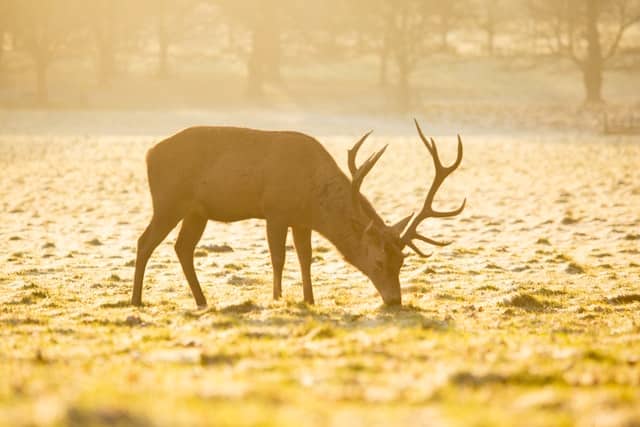
Habitat
Red deer in England and southern Scotland typically favor woodland and forest settings but are also well-adapted to open moors and hills, as seen in parts of Scotland and south-west England. The native population is prominent in the Scottish Highlands, Dumfriesshire, the Lake District, East Anglia, and the south-west of England, while feral groups are found in northern England, the North Midlands, East Anglia, the New Forest, and Sussex.
Their diet mainly consists of grasses and dwarf shrubs like heather and bilberry. In winter, when food is scarce, they also feed on woody plants, such as tree shoots. This diet, particularly their grazing on tree shoots and agricultural crops, often puts them at odds with farmers and foresters due to the economic damage caused. On the flip side, red deer contribute to the economy through recreational stalking and venison production on many country and forest estates. Besides being a source of venison, they are also kept for ornamental purposes in parks across the UK.
The management of red deer populations is crucial. It involves balancing their needs with the environment, maintaining their health and quality, and addressing the conflicting aspects of their existence, whether as a source of conflict or as a valuable resource. This careful management ensures the sustainability of red deer populations within their habitats.
Lifecycle
In England, the red deer’s mating season, known as the rut, spans from late September to November. During this time, stags venture into the hinds’ territory and engage in various displays to establish dominance and attract mates. These displays include loud roaring, parallel walking, and in some cases, physical combat. Fights, which can sometimes lead to serious injuries or even death, typically occur between stags of similar size when dominance cannot be determined through other non-violent means. Once a stag establishes himself as the dominant male, he secures exclusive mating rights with the hinds in the area.
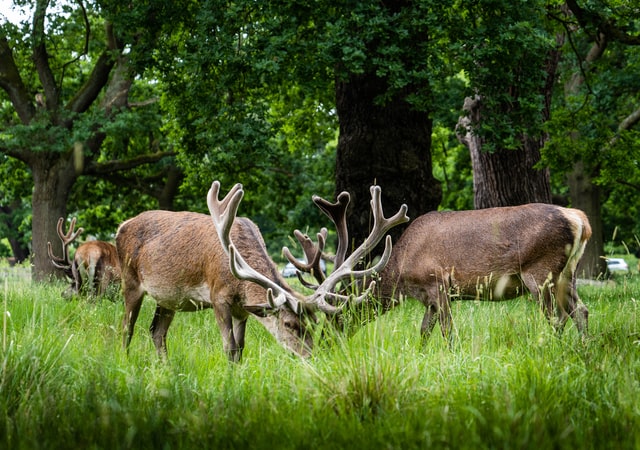
While red deer in England’s productive woodland populations reach sexual maturity before their second year, it’s usually the stags over five years old that engage in mating. In these woodlands, hinds as young as one year can give birth to a single calf after an eight-month gestation period, typically from mid-May to mid-July. However, in hill hinds, puberty may be delayed until they are three, and they might only reproduce every two or three years. In some Scottish hill populations, there is a high rate of infant mortality both at birth and during the first winter. Exceptionally, red deer can live up to 18 years.
Woodland red deer often lead solitary lives or form mother-calf pairs. In open areas, larger single-sex groups are common, merging only during the rut. In the Scottish Highlands, these large groups can remain together for most of the year. Red deer are active throughout the day, with heightened activity at dawn and dusk, especially in areas where they frequently encounter disturbances. In the Scottish Highlands, they typically roam the open hills during the day and move to lower elevations at night.
During the rut, stags are known for their roaring and grunting sounds. Hinds bark when they sense danger and moo when looking for their calves. Calves, when alarmed, emit a high-pitched squeal and can bleat to communicate with their mothers.
Gray Seals
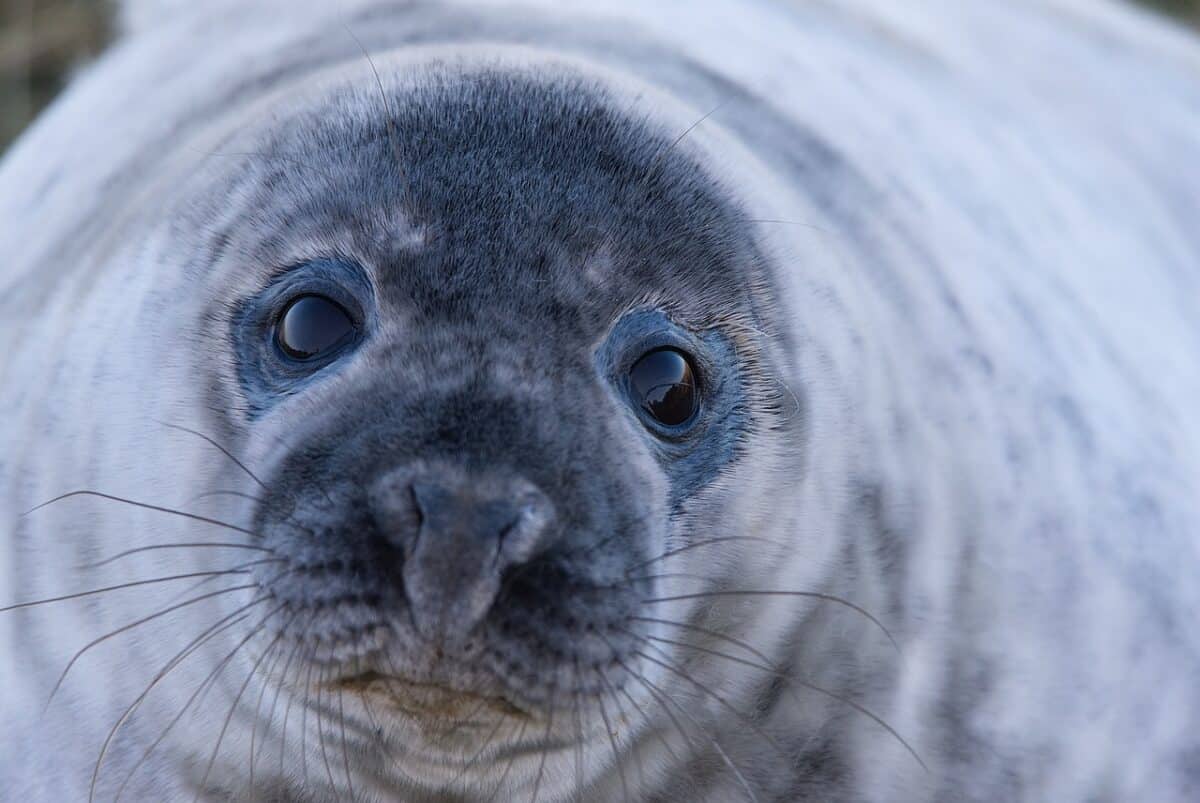
The grey seal, known scientifically as Halichoerus grypus, which translates to ‘hook-nosed sea pig’, is the larger of the two seal species found in the UK. These marine mammals spend the majority of their time in the sea, primarily feeding on fish. They are often seen on land, especially on British beaches, where they come to rest and are commonly observed ‘hauled out’ – lying around. In the autumn, grey seals are known for giving birth to fluffy white pups, which remain on land until they shed their white fur and triple their initial body weight.
Identifying Features
Grey seals can be identified by their larger size compared to common seals and their distinctively long heads with a sloping ‘roman nose’ profile. When viewed head-on, their nostrils appear parallel, unlike the v-shaped nostrils of common seals. Their primarily grey fur, marked with a unique pattern of darker blotches and spots, is another characteristic feature, helping in the identification of individual seals.
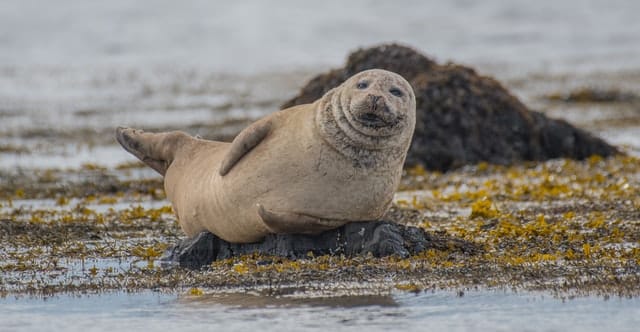
How people can help
Grey seals in the UK, numbering around 112,000, choose the autumn months, from late September to December, for their breeding season. They have a preference for remote and uninhabited islands, often returning to the same breeding site each year. A female grey seal gives birth to a single pup, weighing approximately 14kg, and familiarizes herself with the pup’s scent immediately after birth. These pups are fed five to six times daily for about 16 to 18 days, during which they more than double their weight. After this period, they are weaned and shed their white fur, marking a significant milestone in their early life.
Grey seals are a significant part of England’s wildlife and are distributed variously along the UK coastline. They are particularly plentiful around the Outer Hebrides and the Orkney Islands in Scotland. While smaller populations are present off the coasts of Wales, Cornwall, and Norfolk, larger groups can be found off the Lincolnshire coast, the Farne Islands, the Isle of May, and the Shetland Islands, showcasing their widespread presence in the region.
Making headlines
Watch this amazing video about this naughty seal who was first rescued in the Netherlands and then again in London! Quite the traveller…
Hedgehogs
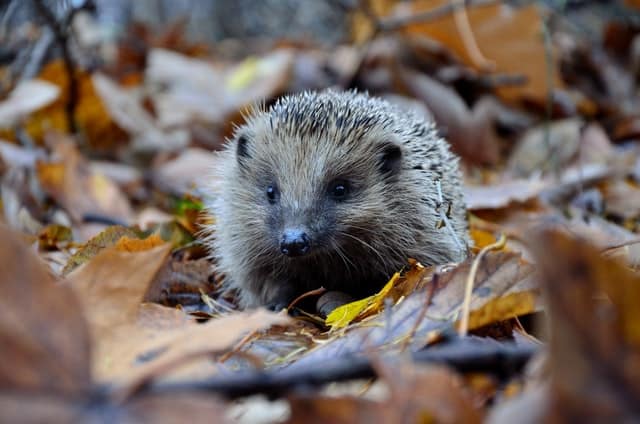
Hedgehogs are diminutive mammals known for their distinct cone-shaped faces, short legs, and bodies adorned with spiky, porcupine-like quills. Although they bear a resemblance to porcupines, they are not closely related. A key difference lies in their quills: unlike porcupines, a hedgehog’s quills are firmly attached to its body and do not detach easily.
These quills are composed of keratin, the same substance found in human nails. According to the African Wildlife Foundation (AWF), a single hedgehog can sport up to 6,000 quills. In response to threats, hedgehogs employ a unique defensive tactic: they roll into a tight ball, ensuring their quills cover all vulnerable areas of their body, thus safeguarding themselves against predators. Contrary to popular belief, hedgehogs remain stationary when curled up in this defensive position and cannot roll around.
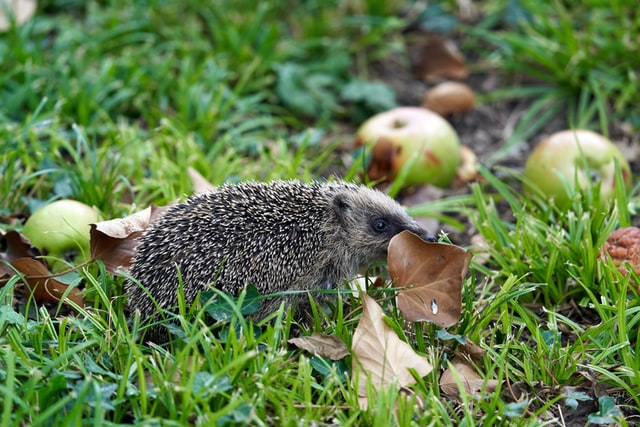
Hedgehogs, known for their solitary nature, are avid sleepers, often resting for up to 18 hours a day. They are nocturnal animals, preferring to sleep during daylight hours, which might make them less ideal as pets for those seeking a daytime companion.
Their activity peaks at night when they venture out in search of food. Due to their relatively poor eyesight, hedgehogs depend heavily on their sense of hearing and smell to locate food. Interestingly, they possess up to 44 teeth, which aid in their feeding habits.
Beyond just resting, sleep serves as a critical survival mechanism for hedgehogs, helping them cope with harsh environmental conditions. In cold climates, they hibernate to conserve energy and survive the winter. Similarly, during periods of intense heat and drought, particularly in desert environments, hedgehogs undergo aestivation – a form of prolonged sleep. However, in regions without such extreme conditions, hedgehogs maintain a more regular activity pattern and normal sleep cycles.
Diet
The name “hedgehog” is derived from their unique foraging habits. These creatures are often found rummaging under hedges and in dense vegetation, emitting snorting sounds reminiscent of a hog while searching for food. Their diet is surprisingly diverse, encompassing fruits, fungi, centipedes, insects, snails, worms, mice, frogs, eggs, birds, reptiles, roots, and even snakes. Remarkably, a hedgehog is capable of consuming up to one-third of its body weight in a single night, showcasing their efficient and varied feeding behavior.
Basking Sharks

Despite its formidable appearance, the basking shark, often seen in the waters around the United Kingdom, is far from menacing. Ranking as the second-largest existing shark species, surpassed only by the whale shark, the basking shark exceeds even the great white shark in size. These giants are filter feeders, thriving on the ocean’s tiniest organisms to reach their massive size.
Basking sharks can grow to extraordinary lengths, with some recorded at over 40 feet and weighing up to 16 tons. Despite their size and a jaw that spans 3 feet wide, they are gentle giants, known for their slow movement, docile nature, and lack of sharp teeth. This has unfortunately made them a prime target for fishing industries, leading to a drastic decline in their numbers and their classification as an endangered species.
Contrary to their intimidating appearance, basking sharks pose no threat to humans. They are known for their peaceful interactions with snorkelers and divers, often circling them calmly. Their diet consists solely of plankton, which they follow through the ocean, migrating thousands of miles annually in pursuit of plankton blooms, diving as deep as 3000 feet.
Basking sharks have an intriguing reproductive method known as ovoviviparity, where the eggs develop inside the female instead of being laid externally. The young sharks grow to nearly 5 feet within their mother before birth, protected from predators. This reproductive strategy, combining elements of egg-laying and live birth, is an example of the diverse adaptations seen in the animal kingdom. In some cases, it is believed that the young may even consume unfertilized eggs as a source of nutrition while developing inside the mother.
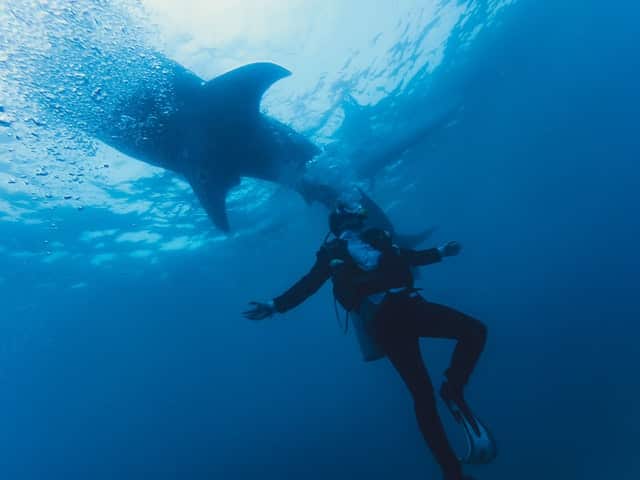
The young basking sharks, after a gestation period of 2 to 3 years, are born at an impressive size of nearly 5 feet in length, which might appear to us as fully grown sharks. However, they still have a considerable journey ahead to reach their potential size of nearly 40 feet. Being born at such a large size provides them with a natural advantage, as it minimizes the number of predators that can threaten them in their early stages of life. Despite this head start, the primary threat to their survival comes not from natural predators but from humans. Intensive harvesting by humans has pushed basking sharks perilously close to extinction.
Summary on Wildlife in England
The wildlife in England is far from mundane, boasting a range of fascinating creatures from the adorable seals and hedgehogs to the majestic red deer and awe-inspiring basking sharks. These species represent just a snippet of the diverse animal life native to the United Kingdom. This richness in wildlife might just inspire you to keep a keener eye out for these natural wonders on your next visit to England.
If you’re interested in seeing animals when there in a more formal way, have a look at the following potential operators:
Padstow Sea life Safaris To see some basking sharks in Cornwall
Thank you for reading Wildlife in England.
Frequently Asked Questions (FAQs)
England boasts a diverse range of wildlife including red deer, gray seals, hedgehogs, basking sharks, various bird species, foxes, badgers, rabbits, and more.
England is home to a significant variety of wildlife, ranging from mammals, birds, and marine life to insects and plants.
England is often associated with the red deer, which is native to the country and holds cultural significance. Additionally, gray seals and hedgehogs are well-known inhabitants of England’s wildlife.
One of the largest wildlife species in England is the red deer. These majestic animals can be found in various regions of the country.
The most common animal species in England may vary, but animals like rabbits, foxes, and various bird species are often encountered due to their adaptability to urban and rural environments. Hedgehogs and squirrels are also quite common in many areas.
- 5 Best Places to See African Wild Dogs - April 24, 2024
- Best Places to See Giant Pandas - April 23, 2024
- Sea Snakes: A Complete Guide - April 23, 2024

